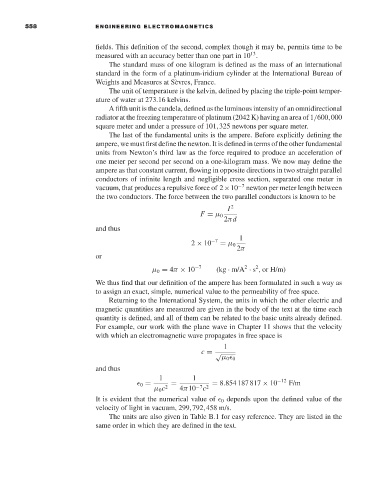Page 576 - Engineering Electromagnetics, 8th Edition
P. 576
558 ENGINEERING ELECTROMAGNETICS
fields. This definition of the second, complex though it may be, permits time to be
13
measured with an accuracy better than one part in 10 .
The standard mass of one kilogram is defined as the mass of an international
standard in the form of a platinum-iridium cylinder at the International Bureau of
Weights and Measures at S`evres, France.
The unit of temperature is the kelvin, defined by placing the triple-point temper-
ature of water at 273.16 kelvins.
A fifth unit is the candela, defined as the luminous intensity of an omnidirectional
radiator at the freezing temperature of platinum (2042 K) having an area of 1/600,000
square meter and under a pressure of 101,325 newtons per square meter.
The last of the fundamental units is the ampere. Before explicitly defining the
ampere, we must first define the newton. It is defined in terms of the other fundamental
units from Newton’s third law as the force required to produce an acceleration of
one meter per second per second on a one-kilogram mass. We now may define the
ampere as that constant current, flowing in opposite directions in two straight parallel
conductors of infinite length and negligible cross section, separated one meter in
vacuum, that produces a repulsive force of 2×10 −7 newton per meter length between
the two conductors. The force between the two parallel conductors is known to be
I 2
F = µ 0
2πd
and thus
1
2 × 10 −7 = µ 0
2π
or
2
2
µ 0 = 4π × 10 −7 (kg · m/A · s , or H/m)
We thus find that our definition of the ampere has been formulated in such a way as
to assign an exact, simple, numerical value to the permeability of free space.
Returning to the International System, the units in which the other electric and
magnetic quantities are measured are given in the body of the text at the time each
quantity is defined, and all of them can be related to the basic units already defined.
Forexample, our work with the plane wave in Chapter 11 shows that the velocity
with which an electromagnetic wave propagates in free space is
1
c = √
µ 0 0
and thus
1 1
0 = = = 8.854 187 817 × 10 −12 F/m
µ 0 c 2 4π10 c
−7 2
It is evident that the numerical value of 0 depends upon the defined value of the
velocity of light in vacuum, 299,792,458 m/s.
The units are also given in Table B.1 for easy reference. They are listed in the
same order in which they are defined in the text.

